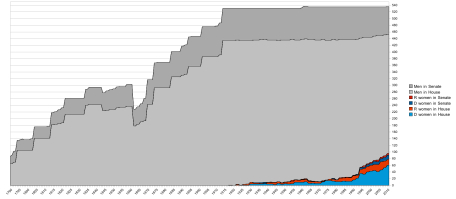As if to unite Ryan’s irritation with sensational headlines at The Atlantic with Liz’s observation that “Ladies’ Night” seems to be the leading media theme in the wake of Tuesday’s primaries, Chris Good at The Atlantic has a post up that asks, is this “The End of Men in Politics?”
Good works through the key data points from Tuesday—wins by Meg Whitman, Carly Fiorina, Sharron Angle, and Blanche Lincoln, plus the commanding lead held by Nikki Haley in South Carolina’s GOP gubernatorial race—and touches on women’s gains in the business and education worlds, chronicled by his colleague Hanna Rosin in the current Atlantic, on the way to his conclusion:
Maybe the same thing is happening in politics. Men have had it easy for so long, consciously or unconsciously taking into account their good-ole-boy advantages, all clubby assumption and the ease of less pressure–just as women, entering the professional world, know about the history of the women’s movement, of the glass ceiling, and are determined not to fail, having something to prove while men, given no historical or immediate disadvantage, find themselves bereft of a natural incentive structure–that maybe they’re getting soft and the women will just take over.
Women seem more naturally adept at politics, anyway, being generally more sentient communicators. In the world of politics, multi-directional awareness is paramount. Men can barely listen when they watch TV. Stereotypically, men are better suited to a single logical task, rather than the complex interactions of a social group. It seems clear which ability is more useful in a campaign.
More and more women are coming into power. Not all of the above candidates will win in November. But it’s worth noting that today’s stories about the success of women candidates is not a stand-alone thing; it’s part of a larger social trend.
That last paragraph, at least, is plainly true: there’s a (very welcome) long-term trend toward female success in politics that trails, but reflects, progress in the rest of society. Meanwhile, talk about biological differences that may support this trend is highly speculative, but it’s not crazy. And I get that Good’s headline is a nod toward Rosin’s article, which is titled “The End of Men.”*
But still—some perspective, please. On Tuesday morning, David Bernstein of The Boston Phoenix took a close look at the “big day for women in politics” storyline, specifically focusing on Republican primary contests. By his count:
• At most, five of the thirty-five Republican nominees for Senate seats will be women
• At most, there will be seven female Republican gubernatorial nominees, out of nearly forty races
• And of the 243 Republican nominees for House seats chosen to date, 20 are women (two more are headed to run-offs)
I don’t have the comparable Democratic figures handy, but while elected women in office have historically been more prominent in that party, they’ve also remained a small minority. Here’s a visual demonstration of federal legislators in the period 1790-2010, courtesy of the site Timeplots. The grey areas are men in Congress; the colored areas are women; the largest blue patch is female House Democrats (click the image to get to a larger version at the Timeplots site):
If you prefer charts to graphics, here’s The Washington Post’s ranking of countries according to the share of seats in the lower house of their federal legislature that are held by women. In the U.S., it’s 16.8 percent. That puts us in 74thplace, in a tie with Turkmenistan.
All of which is to say that while the trend is in the right direction, we are a long, long way from gender equality, let alone the end of men in politics. And while the change augured by Tuesday’s results is perhaps more substantial than Bernstein’s numbers suggest—all elected offices are not created equal, and senator from and governor of California are pretty significant seats—that imbalance will remain very much the case at the start of 2011, however the rest of the campaign plays out.
*Parenthentically, how does The Atlantic decide, when it’s decreeing the end of one embedded power structure or another, whether to hedge its bets with a question mark? Hua Hsu’s cover story from the Jan/Feb ’09 issue, “The End of White America?”, was made into a question, the title of Rosin’s piece is a straight-up declaration, and with Good’s post we’re back to a question. Is there an internal style guide on this point?
Greg Marx is an associate editor at CJR. Follow him on Twitter @gregamarx.

